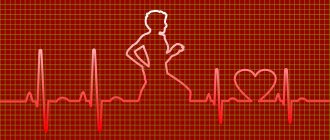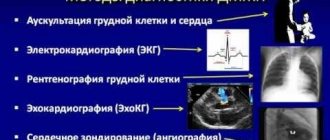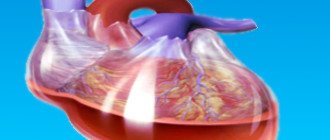Sign up
+7
Pericarditis is a heart disease manifested by an inflammatory process localized in the serous membrane of the organ. Acute pericarditis is an inflammatory syndrome with or without pericardial effusion (effusion). The diagnosis of subacute pericarditis is established when its duration is from 4-6 weeks to 3 months without remission. Recurrent pericarditis is diagnosed after a documented first episode of acute pericarditis and a symptom-free period of 4-6 weeks or longer (usually about 18-24 months).
Chronic pericarditis lasts longer than 3 months without remission. It can develop in various forms - asymptomatic, effusion, with lime deposits - the so-called “shell heart”, constrictive.
In whatever form the disease manifests itself - constrictive, effusion, etc. – it requires quick diagnosis and proper effective treatment.
Make an appointment with a specialist without queues, at a convenient time
Sign up
+7
What is pericarditis
Pericarditis is an inflammation of the pericardium, the thin, two-layered sac that surrounds the heart.
There is a small amount of liquid between the layers to prevent friction during beating. When the layers become inflamed, this can lead to disruption of the full functioning of the heart, the formation of adhesions in the cavity, fluid accumulation and chest pain. The pericardium also helps keep the heart inside the chest. Pericarditis usually occurs suddenly and lasts from several days to several weeks.
Anyone can get pericarditis. In most cases, it goes away on its own. However, 15 to 30% of people get it more than once—this is called recurrent pericarditis.
There are several forms of pericarditis:
- acute - it can occur on its own or as a symptom of an underlying disease;
- recurrent - can be periodic or constant, the first recurrence usually occurs within 18 - 20 months from the initial illness;
- chronic - in this case, relapse occurs immediately after treatment;
- delayed (Dressler syndrome) - it develops several weeks after heart surgery or a heart attack;
- constrictive - the pericardium scars or sticks to the heart so the heart muscle cannot expand (this form is rare and can develop in people with chronic pericarditis or after heart surgery);
- effusion-constrictive pericarditis - in this case, effusion (fluid) accumulates in the pericardium and a narrowing of the heart occurs.
One third of people with pericardial effusion develop cardiac tamponade, which requires emergency medical attention.
Types of pericarditis: chronic and acute pericarditis
The following types of pathologies are distinguished:
- Primary. The disease is independent.
- Secondary. The disease is a complication of other pathologies.
Pericarditis can be:
- Limited.
- Partial.
- Generally spilled.
Depending on the clinical features, the following are distinguished:
- Acute pathology. It develops quite quickly, can be dry or fibrinous, effusion or exudative.
- Chronic pathology. It develops over several months and can be effusion or adhesive (adhesive). The latter represents residual effects of pathology of various origins. Adhesive pericarditis can be asymptomatic, with functional disorders of cardiac activity, with deposits of calcium salts, etc.
Causes of pericarditis in adults
The cause of most pericarditis is unknown, but 80 to 90% of cases are thought to be associated with infections (viruses, bacteria, fungi, and parasites).
In addition, pericarditis can be caused by:
- cardiovascular problems (previous heart attack or surgery);
- injuries;
- radiation therapy;
- autoimmune diseases such as lupus;
- some medications, which is rare;
- metabolic disorders such as gout;
- renal failure;
- some genetic diseases, such as familial Mediterranean fever;
- cancer;
- some medications.
Prevention
Preventive measures for the occurrence of secondary pericardium include regular monitoring by a cardiologist, heart examination, and timely treatment of infections.
Moderate physical activity, a balanced diet and a healthy lifestyle in general are recommended as supportive measures.
The medical center provides a full range of services for the treatment of various cardiovascular diseases. The center's experienced specialists will make an accurate diagnosis and prescribe effective treatment. Timely medical care will keep you healthy for many years. Appointments with SM-Clinic specialists are available around the clock.
Symptoms of pericarditis in adults
Pericarditis can feel like a heart attack with sudden, sharp or stabbing pain in the chest.
The pain may be in the middle or left part of the chest, behind the breastbone, and may spread to the shoulders, neck, arms or jaw. Other symptoms may include:
- temperature;
- dry cough;
- weakness or fatigue;
- difficulty breathing, especially when lying down;
- cardiopalmus;
- swelling of the feet, legs and ankles.
Symptoms that occur may worsen if the patient lies down, takes deep breaths, coughs, eats, or drinks.
But if he sits leaning forward, it gets better. If the cause of pericarditis is a bacterial infection, the patient may have fever, chills, and a higher than normal white blood cell count. If the cause is viral, there may be flu-like symptoms or stomach upset.
In any case, if chest pain appears (it happens in 85 - 90% of cases), you should immediately call an ambulance.
Diagnostics
Other tests used for diagnosis include:
- a chest x-ray, which shows the shape of the heart and possible excess fluid;
- an electrocardiogram (ECG) to check your heart rhythm and see if the voltage signal is decreasing due to excess fluid;
- an echocardiogram, which will also show the shape, size of the heart and fluid accumulation;
- MRI;
- computed tomography, which provides a detailed image of the heart and pericardium;
- right heart catheterization, which will provide information about the pressure in the heart;
- blood tests to look for inflammatory markers that indicate pericarditis.
Diagnosis of acute and chronic pericarditis
Before treating the pathology, specialists conduct a thorough diagnosis.
It includes:
- Taking anamnesis and examining the patient.
- Conducting a number of laboratory tests. Specialists are especially interested in indicators such as total protein and its fractions, urea, fibrinogen, creatine kinase, sialic acids, seromucoid, CRP, LE cells. Patients must undergo a blood test.
- ECG. This study is especially relevant when determining acute dry pathology and the initial stage of exudative pathology.
- FCG (phonocardiography). In this study, pathological symptoms such as systolic and diastolic murmurs, which are not associated with the functional rhythm, and high-frequency fluctuations that occur periodically are noted.
- X-ray of the lungs. This study is informative in detecting exudative pathology. Experts detect an increase in size and a change in the silhouette of the heart muscle.
- CT scan of the chest.
- MSCT and MRI of the heart muscle.
- EchoCG. This research methodology is the main one. It allows you to determine the presence of even a small amount of exudate in the pericardial cavity. The study also makes it possible to detect changes in the movements of the heart muscle, the presence of adhesions and thickening of the pericardial layers.
If it is necessary to examine the exudate, diagnostics are carried out in the form of pericardial puncture and biopsy. The correct diagnosis is made quickly enough. The doctor only needs to study each symptom and conduct an objective comprehensive examination.
Modern methods of treatment
Treatment for pericarditis will depend on its underlying cause.
If it is a bacterial infection, antibiotics may be prescribed. In most cases, according to the American Heart Association, pericarditis is mild and goes away on its own - you just need to rest. But the doctor may prescribe non-steroidal anti-inflammatory drugs (Ibuprofen, Aspirin). If there are other medical risks, the patient may be hospitalized. In this case, therapy will be aimed at reducing pain, inflammation and minimizing the risk of relapse. As a rule, Colchicine is prescribed in this case.
Corticosteroids are also effective in reducing the symptoms of pericarditis, however, studies have shown that early use of these drugs may have an increased risk of recurrence of the disease and should be avoided except in extreme cases where the disease is refractory to conventional treatment.
Surgery may be considered for recurrent pericarditis that does not respond to other treatments, in which case the pericardium is removed.
Reasons for the development of the disease
This cardiac disease has a polyetiological nature:
- Infectious causes include rheumatic, tuberculous, bacterial. In addition, pericarditis can have a fungal or viral etiology, for example, with influenza.
- Aseptic reasons include allergies, diffuse connective tissue diseases, hematological diseases, malignant processes, injuries, radiation exposure, hypovitaminosis.
- Idiopathic pericarditis may also develop, the cause of which cannot be determined. It is these pathologies that are most often prone to relapse.
Popular questions and answers
We asked cardiologist Stanislav Snikhovsky to answer questions about pericarditis.
What complications can occur with pericarditis?
In general, pericarditis is considered a disease with a favorable outcome, since timely, qualified care leads to complete recovery in most patients. In rare cases, with severe disease, the following complications may occur:
- thickening or sticking together of the pericardial layers (external and internal), which leads to difficulty in the functioning of the heart and the development of heart failure;
- cardiac tamponade (accumulation of a large amount of fluid between the layers of the pericardium), which also leads to difficulty in the functioning of the heart, the development of heart failure and possible cardiac arrest;
- the formation of fistulas (holes) of the internal mammary artery - this is possible only with purulent pericarditis and is a rare complication.
After pericarditis, cardiac conduction disturbances may occur for a long time. They manifest themselves as periodic attacks of arrhythmia (especially during physical activity).
When to call a doctor at home if you have pericarditis?
Pericarditis usually develops gradually.
Therefore, if major complaints and symptoms occur, you must consult a doctor for diagnosis. Most often, patients complain of shortness of breath (at rest or with light physical exertion), pain in the heart area, palpitations, and general weakness.
Is it possible to cure pericarditis with folk remedies?
There are many treatment options for pericarditis.
As a rule, they depend on the cause of pericarditis (treatment of the disease that caused pericarditis leads to the disappearance of symptoms of pericarditis, up to recovery). Only a doctor can prescribe treatment for pericarditis after a complete examination and determination of the cause of the disease. Folk remedies in the treatment of pericarditis are used as additional therapy and only in the treatment of dry (fibrinous) pericarditis. Among them:
- decoction of young pine needles;
- a collection of hawthorn, calendula, linden flowers and dill;
- infusion of birch catkins;
- collection from the root of valerian officinalis, yarrow and lemon balm leaves.
Published on the portal kp.ru
Classification options
Pericarditis is divided into acute, which resolves within 6 weeks from onset:
- Catarrhal – associated with the onset of inflammation of the mucous membranes;
- dry (fibrinous) - an inflammatory effusion appears, adhesions form between the layers of the pericardium, preventing the organ from working effectively;
- effusion (exudative) without or with cardiac tamponade. An accumulation of fluid forms in the structures of the organ, which changes its hemodynamics. Separation of the pericardial layers occurs. If there is blood in it, a hemorrhagic type of disease occurs.
Subacute pericarditis, the outcome of which occurs in the period from 6 weeks to six months:
exudative – fluid accumulates in the pericardium;- adhesive - the membranes of the heart undergo an adhesive process;
- constrictive without or with cardiac tamponade - as a result, the ventricles do not change their size, and the atria increase. In some cases, scar tissue deforms the entire pericardium, and calcium deposits may be present, pulling the organ into the so-called “shell.”
Pericarditis can take the form of chronic inflammation, lasting more than six months from the onset. It is characterized by all the same stages as described above.
The main complaint of patients in the acute period is intense pain behind the sternum, radiating to the left shoulder blade, arm or neck. Suffering is somewhat reduced when taking NSAIDs or when the person is sitting and bending forward; an increase is noted when lying on the back. In some cases, the temperature increases, shortness of breath, palpitations occur, and blood pressure decreases.







